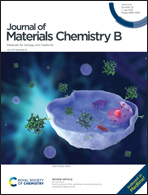A pH/H2O2 dual triggered nanoplatform for enhanced photodynamic antibacterial efficiency†
Abstract
Bacterial infection and biofilms cause non-healing chronic wounds and threaten human health. Although antibiotics still play an irreplaceable role to treat infectious diseases in clinics, increasing attention has been paid to the problem of multidrug resistance (MDR). As a novel strategy to deal with bacterial infection, photodynamic antimicrobial therapy (PDAT) has shown promising potential to reduce bacterial infection, and stimuli-responsive nanomaterials have been shown to enhance the antibacterial efficiency and postpone the emergence of drug-resistant bacteria. In this work, we developed a bacterial microenvironment-responsive nanoplatform to eliminate bacteria and bacterial biofilms under 650 nm laser irradiation. Reversible addition–fragmentation chain transfer (RAFT) polymerization was applied to synthesize an H2O2 responsive block copolymer of POEGMA-b-PBMA, and the antibacterial drug of porphyrin TAPP was loaded to form nanoparticles (PT) by a co-assembled approach. At the infection area with overexpressed peroxide, nanoparticles were disintegrated due to the cleaved boronic ester leading to the release of TAPP. Furthermore, the released TAPP became protonated in the acidic infection area (pH = 5.5) and then enhanced its photodynamic antibacterial efficacy by producing higher singlet oxygen (1O2) levels under light irradiation. Both in vitro and in vivo antimicrobial and biofilm elimination experiments demonstrated that the responsive nanoplatform combined with PDAT has tremendous potential for the treatment of infections.



 Please wait while we load your content...
Please wait while we load your content...